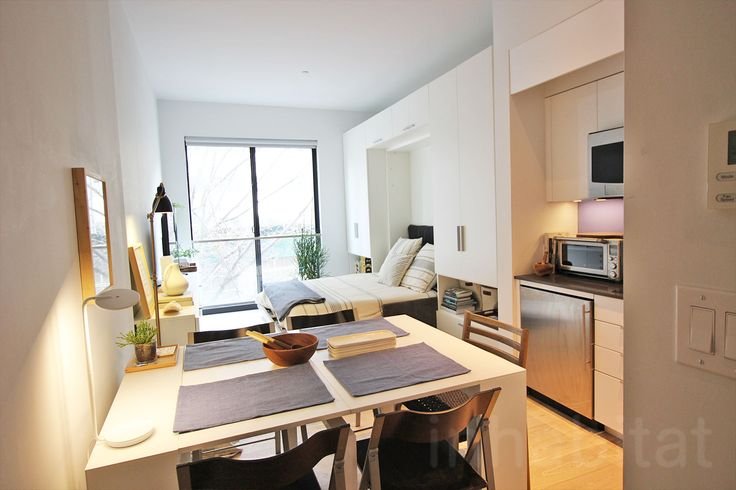In today’s bustling cities, where space comes at a premium and housing costs continue to rise, the concept of micro-living has emerged as a practical solution for maximizing space in urban dwellings. Microliving is all about making the most out of limited space without sacrificing comfort or functionality. It involves innovative design solutions, creative thinking, and a minimalist approach to living. Here, we will explore the principles of micro-living and examine real-world examples of how individuals and designers are embracing this concept to create efficient, stylish, and sustainable living spaces in urban environments.

The Tiny House Movement is perhaps one of the most well-known examples of micro-living. Tiny houses are small, often mobile homes that typically range from 100 to 400 square feet in size. Despite their diminutive dimensions, these homes are designed to provide all the comforts of a traditional house in a compact and efficient package. Tiny house dwellers embrace minimalist lifestyles, paring down their possessions to the essentials and prioritizing experiences over material possessions.

One notable example of a tiny house is the Kasita, a modular micro home designed by Jeff Wilson. The Kasita is a sleek and modern dwelling that maximizes every square inch of space through clever design and smart technology. Measuring just 352 square feet, the Kasita features a flexible layout with transformable furniture, built-in storage, and integrated smart home systems. Despite its small size, the Kasita offers all the amenities of a larger home, including a full kitchen, bathroom, and living area.

Another example of micro-living can be found in micro apartments, also known as micro units or micro flats. These small-scale apartments are typically designed for urban environments where space is limited and housing costs are high. Micro apartments typically range from 200 to 400 square feet in size and are characterized by their efficient use of space and multifunctional design features. Carmel Place, located in New York City, is one of the first micro-apartment buildings in the United States. Developed by Monadnock Development and designed by nARCHITECTS, Carmel Place offers 55 micro apartments ranging from 260 to 360 square feet in size. Each apartment is equipped with space-saving features such as built-in storage, fold-down furniture, and high ceilings to create a sense of spaciousness. The building also includes shared amenities such as a rooftop terrace, fitness centre, and communal lounge, providing residents with additional space to socialize and relax.

Co-living spaces represent another innovative approach to micro-living. Co-living involves sharing living accommodations with others, often in a communal setting with shared amenities and common spaces. Co-living spaces appeal to young professionals, students, and digital nomads seeking affordable housing options and opportunities for social interaction and networking. WeLive, a subsidiary of the co-working giant WeWork, offers fully furnished apartments with flexible leases and communal spaces for residents to work, socialize, and relax. With locations in major cities such as New York, Washington D.C., and London, WeLive aims to create a sense of community and connection among its residents while providing all the comforts and conveniences of modern urban living.

In addition to residential spaces, micro-living principles are also being applied to commercial and public spaces to optimize functionality and efficiency. For example, micro-retail spaces are small-scale storefronts designed to accommodate niche businesses and startups in urban areas. These compact retail spaces offer affordable leasing options and flexible layouts, making them ideal for entrepreneurs and small businesses looking to establish a presence in high-traffic areas. One example of a micro retail space is Boxpark, a pop-up mall made from shipping containers located in London, England. Boxpark features a collection of small-scale retail units housed within repurposed shipping containers, offering a diverse range of shops, restaurants, and bars. The modular design of Boxpark allows for easy customization and reconfiguration, making it a versatile and adaptable space for both businesses and consumers.

Furthermore, micro-living extends beyond physical spaces to encompass lifestyle choices and consumption habits that prioritize simplicity, minimalism, and sustainability. The minimalist movement, for example, encourages individuals to declutter their homes and lives to focus on what truly matters. By embracing a less-is-more philosophy, minimalist living promotes mindfulness, intentionality, and environmental stewardship. Marie Kondo, the bestselling author and organizing consultant, has become a global icon of the minimalist movement with her method of tidying up. Her philosophy, which emphasizes the importance of surrounding oneself with belongings that “spark joy” and getting rid of everything else, has inspired millions of people around the world to declutter their homes and live with less stuff.

Micro-living represents a shift in the way we think about urban living, challenging conventional notions of space and consumption. By embracing innovative design solutions, compact living units, and minimalist lifestyles, individuals and communities can create efficient, affordable, and sustainable living environments in the heart of the city. As urbanization continues to accelerate and space becomes increasingly scarce, the principles of micro-living offer a promising path forward for creating thriving, resilient, and inclusive urban communities.


